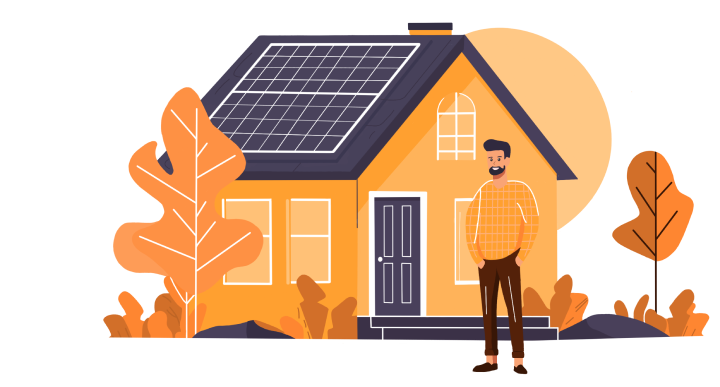Understanding the cost to install solar panel systems is essential for making an informed decision about your home's energy future. The financial aspect of a solar power installation involves various components, including equipment, labor and ongoing solar panel maintenance costs, which can be complex to navigate.
Solar Energy Host simplifies solar installation pricing for you. Our intuitive platform lets you connect with top local providers so you can access the most competitive solar panel quotes with ease.
Knowing Solar Energy Host is the one you can turn to when you're ready to switch to solar, it's time to learn more about the solar installation cost so you can make an informed decision. Here's how to calculate solar panel costs:
Step #1: Assess the key cost of a solar installation.
Equipment costs
Solar panels, inverters and batteries all contribute to equipment costs.
When considering the cost to install solar panel systems, the type and quality of solar panels, inverters and batteries you select can significantly affect the overall price. High-efficiency solar panels, such as monocrystalline panels, tend to be more expensive but offer better energy output compared to polycrystalline or thin-film panels.
Likewise, the choice between a string inverter and a micro inverter can impact both performance and cost, with microinverters generally costing more but providing greater efficiency and reliability. Battery storage systems, like lithium-ion batteries, vary widely in price depending on their capacity and lifespan.
Each component of a solar installation in home has its own price range, and understanding these differences is crucial.
Labor fees
Labor fees will likely be a separate cost with a professional solar power installation.
Hiring professional solar panel installers comes with its own set of costs, typically determined by the job's complexity, your location and the local labor market. For example, installing home solar panels on a two-story house with a steep roof will generally cost more than a single-story house with an easier-to-access, flat roof.
Regional variations in labor costs also play a role; labor rates in urban areas are likely higher than in rural regions. Additionally, some solar panel companies may offer packages that include both the equipment and labor, providing clear visibility into your total cost to install solar panel.
With Solar Energy Host, you can easily make a comparison between the solar panel quotes from various providers.
Step #2: Estimate the cost of installation for your area.
Permits and inspections
Depending on your local regulations, permits and inspections may be required to ensure the solar energy system meets safety and building requirements.
Local municipalities often have specific rules around solar panel installations, and these can include obtaining necessary permits and scheduling inspections. These permits ensure that your solar installation complies with safety standards and building codes, preventing potential issues down the road.
While the costs associated with these permits can vary, typically they are a small fraction of the overall cost to install solar panel systems but essential for legal and safety reasons. Make sure to research the regulations in your area, as they can impact your timeline and budget.
Regional pricing differences
The average cost to install solar panels can vary significantly depending on your location.
In areas with higher local labor rates, you can expect to pay more for installation services compared to regions with lower labor costs. Similarly, material availability and local demand for solar installations can influence pricing; higher demand can drive prices up, while abundant materials and competition among suppliers can keep costs lower.
Understanding these regional factors can help you better estimate your installation costs.
Step #3: Determine how much solar energy you'll likely need.
Calculate your home's energy usage to determine your ideal size system.
Knowing your home's energy usage is essential for choosing the right size solar system.
To determine how much solar energy you will need, start by examining your electricity bills for the past year to find your average monthly energy consumption. Look for the kilowatt-hour (kWh) usage on your statements, as this will give you a baseline. Once you have your yearly consumption, you can work with solar installers to calculate the size of the solar system required to meet your energy needs.
Aligning system size with long-term savings
When you have a clear understanding of your household's energy usage, you can make an informed decision about the size of the solar system that will provide the best return on investment. A system that matches your energy profile not only reduces your reliance on grid electricity but also maximizes the financial benefits of solar power for homes over time.
Properly sizing your system is crucial for maximizing long-term savings.
Trusting the right partner
Solar Energy Host is your trusted partner in harnessing the power of the sun.
Once you've decided to go with solar panels vs. traditional energy sources, Solar Energy Host is where you can connect with top local solar panel installers, ensuring you get competitive quotes tailored to your needs. Our platform simplifies the process by offering only the best solar installation companies in your area, saving you the hassle of manually searching for solar panel financing and services.
Frequently Asked Questions (FAQ)
How can I estimate the cost of solar panel installation for my home?
You can estimate the cost to install solar panel systems based on several key factors.
Your household's energy usage will determine the size of the system you'll need. The more energy you consume, the larger and costlier the system may be. Additionally, local labor rates can vary drastically and equipment costs also play a significant role depending on the quality and type of technology selected.
Taking all these factors into account gives you a clearer picture of the likely cost of solar installation you need to cover.
How does the type of solar panel technology affect the cost?
The type of solar panel technology you select will significantly affect the cost to install solar panel systems.
High-efficiency panels usually come at a higher price but can potentially offer superior energy output per square meter. They are particularly useful if you have limited roof space and need to maximize energy production. On the other hand, polycrystalline panels are more cost-effective but provide slightly less solar panel efficiency.
What are the maintenance costs for solar panels after installation?
It is not uncommon for solar energy yields to be lost due to "soiling," which can reduce efficiency. While solar panels themselves usually require minimal maintenance, you might face minor repairs or the need to replace inverters over time. Maintenance costs are generally low, but accounting for them helps in planning your overall solar investment.
Switch to solar with Solar Energy Host
Now that you know how to calculate the cost to install solar panel for savings, it's time to discover the top rated solar installers in your area.
Begin your search with Solar Energy Host—simply enter your information, compare quotes and select the best offer for your needs. Join countless homeowners who have switched to a sustainable future and enjoy significant savings. Get started with us today and see for yourself why we are the go-to resource for those looking to reduce their electricity bills through solar power.
Start saving today with Solar Energy Host!














